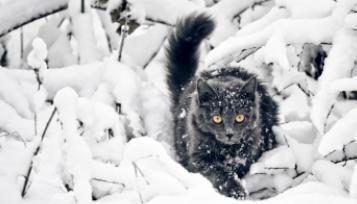
- posted: Feb. 01, 2021
The cold winter months can be difficult for community/stray cats, despite their capability of surviving outdoors. Extreme winter weather can make it difficult for cats to find food, water, warmth and shelter, and can also lead to frostbite and other more serious health conditions, including fatalities.
Thankfully, there are ways that we as a community can help community cats in our neighborhood! We would like to share some things that you can do to help community cats stay safe this winter season!
Build a shelter
Providing cats with a warm, safe place to shelter them from harsh, cold winters is an excellent way to support community cats in your neighborhood!
According to the Neighborhood Cats website, winter shelters are critical for community cats to help them survive the frigid climates!
An adequate shelter is one that is properly sized, well insulated and waterproof! Your local SPCA/Animal shelter to ask if they have pre-made cat shelters available for you to pick up for community cats! Be sure to clear the entryways of the shelters during heavy snowfalls so that local cats can shelter from the cold and snow!
Below are some general guidelines we suggest using if you would like to build your own shelter for cats in your neighborhood. We have also included a link to the Neighborhood cats website that has further and more specific tips on how to create a winter cat shelter.
https://www.neighborhoodcats.org/how-to-tnr/colony-care/feral-cat-winter-shelter
Size: It is best to create a shelter large enough to house 1-2 cats as community cats may huddle together to stay warm. 76L tote bins work well to create an adequately sized shelter.
Insulation: Avoid using materials that absorb body heat, cause irritation and absorb moisture such as, blankets, towels, folded newspaper, hay or similar materials that lie flat on the floor. Straw or shredded newspaper works best as it doesn’t absorb body heat and allows cats to burrow! Be sure to replace the materials regularly to ensure the insulating materials are not moist or dirty!
Building materials: There are several options for various building materials for your shelter. Wood, heavy cardboard, storage/tote bins and Styrofoam shipping boxes work well!
Location/Placement: Your cat shelter should be placed in a quiet place away from excessive foot traffic and somewhere where the cats will feel safe from predators. Placing the shelter close to a wall can provide some protection from the wind. Be sure to not place the shelter out in the happen, but rather under or against something, such as a building, fence, tree, porch etc. Raising the shelter off the ground by placing them on pallets or bricks can help prevent flooding. You can also camouflage the shelters with branches and twigs and if possible, painting them with an exterior deck paint to blend the shelter in with their surroundings. Placing catnip at the entrances of the shelters can encourage local cats to start using them.
Ensure access to fresh food and water
Supplying community cats with fresh food and water is crucial in helping them stay healthy and warm this winter! Consider building a food and water station protected from the cold and placed near the sleeping shelter. An insulated feeding station can be built in the same manner as a sleeping shelter!
Food: Cats should be fed larger portions in the winter compared to other seasons to help them conserve energy. Either dry or wet commercial cat food can be used, however, we recommend feeding dry food as some wet food can freeze in extremely cold temperatures. The times at which community cats are fed should remain consistent every day.
Water: Water bowls should be replaced regularly/daily to ensure a constant source of fresh, clean drinking water and to ensure the water has not frozen. Consider placing a microwaveable heating pad under the bowls to make sure the water does not freeze.
Tap your car
During the winter and colder months, community cats will gravitate towards warm places to try and find a place to shelter and stay protected from the cold. They often will crawl into wheel wells or other parts of cars to try and find some warmth. To a cat living outside, there are many hiding spots and nooks in a car that look very inviting and cozy! Wheel wells are just one place they may attempt to find shelter. They may also find a warm spot by crawling under the hood into the engine itself. Before starting your car engine or driving, knock on the hood of your cat a couple of times in case part of your car Is being used by a local cat for warmth. Be sure to check between your tires and wheel wells as well.
Avoid using chemicals/Antifreeze
Antifreeze can be toxic and deadly to community cats if ingested. Be sure to keep it out of reach and clean up spills! Most antifreeze brands use ethylene glycol as the main ingredients, which is extremely toxic to cats. Consider switching to a brand made with propylene glycol. Although it is still toxic, it is less harmful to our feline friends. (Check out our blog on Antifreeze poisoning for more information! https://www.oakvillevets.com/blog/257154-antifreeze-poisoning )
Salt and other chemicals used to melt snow can also be lethal to our feline friends when licked off paws or ingested from melting puddles. The salt can also hurt cats’ paw pads. Consider switching to a pet friendly deicer which can be found at most pet stores!
Office Hours
8:00 AM - 8:00 PM
9:00 AM - 2:00 PM
Closed
Location
2319 Lakeshore Rd W.
Oakville, ON L6L 1H2, Canada


